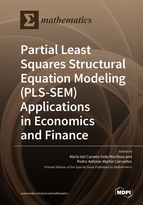Partial Least Squares Structural Equation Modeling (PLS-SEM) Applications in Economics and Finance
A special issue of Mathematics (ISSN 2227-7390). This special issue belongs to the section "Financial Mathematics".
Deadline for manuscript submissions: closed (31 October 2021) | Viewed by 56068
Special Issue Editors
Interests: financial mathematics; financial operations; partial least squares structural equation modeling; panel data linear regressions; logit and probit models; applied econometrics; ethical banking; gender economics studies; health economics; corporate social responsibility
Special Issues, Collections and Topics in MDPI journals
Interests: applied econometrics; behavioral finance; corporate social responsibility; experimental economics; gender economics studies; globalization; green economics; health economics; international business management; Islamic banking and finance
Special Issues, Collections and Topics in MDPI journals
Special Issue Information
Dear Colleagues,
Partial least squares structural equation modeling (PLS-SEM) represents a new generation statistical data analysis technique that, despite its recent creation, is gaining popularity in academia exponentially: it has attracted the interest of scholars in various methodologies, becoming a vivid and constantly evolving technique. In today’s world, managers of companies and public administrations, academics, and researchers have at their disposal a large amount of data to analyze for decision-making and the discovery of new findings. This requires the establishment of a theoretical framework, the use of sciences such as mathematics and statistics, as well as experience and intuition. In this regard, PLS-SEM involves a multivariate data analysis technique that combines the methodologies of regression and linear analysis. It is widely employed in the field of social sciences, where it is necessary to handle unobservable or latent variables. It allows jointly analyzing the relationships between observable and latent variables (evaluation of the measurement model) and the relationships between latent variables (evaluation of the structural model). Likewise, it is a widespread approach in management, since it allows the study of complex models with innumerable indicators for each latent variable and numerous relationships among latent variables. Thus, this Special Issue focuses on the application of PLS-SEM in Economics and Finance, providing a platform for researchers to present their novel and unpublished papers with attractive results.
Prof. Dr. María del Carmen Valls Martínez
Dr. Pedro Antonio Martín Cervantes
Guest Editors
Manuscript Submission Information
Manuscripts should be submitted online at www.mdpi.com by registering and logging in to this website. Once you are registered, click here to go to the submission form. Manuscripts can be submitted until the deadline. All submissions that pass pre-check are peer-reviewed. Accepted papers will be published continuously in the journal (as soon as accepted) and will be listed together on the special issue website. Research articles, review articles as well as short communications are invited. For planned papers, a title and short abstract (about 100 words) can be sent to the Editorial Office for announcement on this website.
Submitted manuscripts should not have been published previously, nor be under consideration for publication elsewhere (except conference proceedings papers). All manuscripts are thoroughly refereed through a single-blind peer-review process. A guide for authors and other relevant information for submission of manuscripts is available on the Instructions for Authors page. Mathematics is an international peer-reviewed open access semimonthly journal published by MDPI.
Please visit the Instructions for Authors page before submitting a manuscript. The Article Processing Charge (APC) for publication in this open access journal is 2600 CHF (Swiss Francs). Submitted papers should be well formatted and use good English. Authors may use MDPI's English editing service prior to publication or during author revisions.
Keywords
- PLS-SEM
- economics
- latent variable
- structural model
- measurement model







